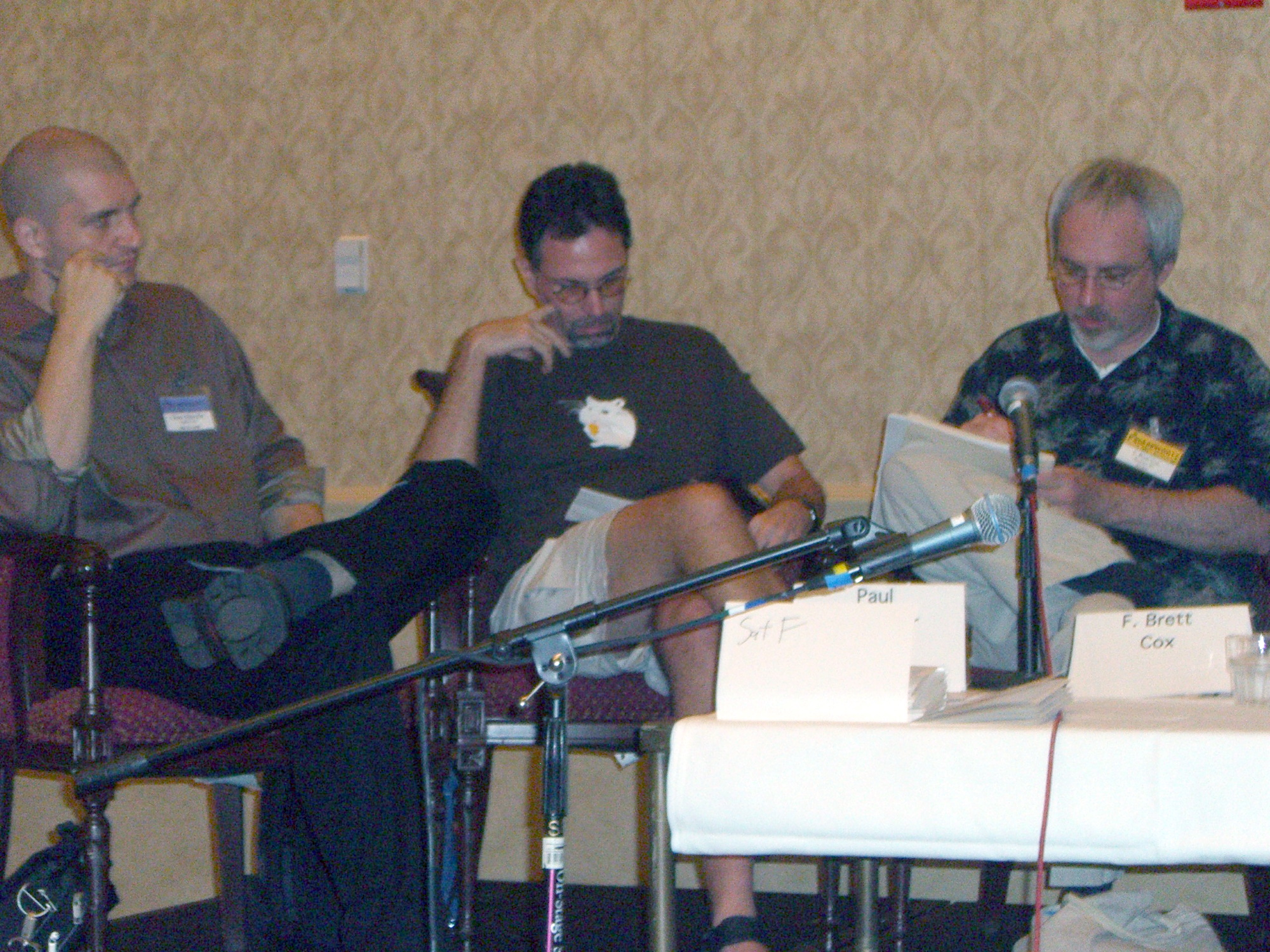Readercon 2006: horror literature and a kaffeeklatsch with Patrick and Teresa Nielsen Hayden
From Within It Devours: a panel on horror
This was a panel where I heard some novel thoughts. Maybe it’s because I don’t know much about horror literature, unlike, for example, about evolution, which was a topic of another Readercon panel.
Here we found out China Mieville’s views on horror.
China Mieville. Non-supernatural horror, in which I am far less interested, is an intrusion of pathology — something wrong, a psychopath, a slasher — whereas supernatural horror is about an eruption of terrible truth. […] I always read Jane Eyre as a horror story.
Brett Cox. Similarly, I’ve always read Who’s Afraid of Virginia Woolf as a work of horror.
And they return to the same idea as the War of Worldviews panel, even though half of the panelists here are different, that something went very wrong with the human nature recently.
John Clute.
If you look at the last couple of centuries, there are more successful stories about twins than there have ever been in human history. If you look at the structure of twin horror stories, you’re gonna find a dynamic that unpacks the whole nature of the last 2 centuries, of how we evolved so rapidly as human beings, that we essentially left our souls behind. One twin is a real person, who the surface person — the first twin — has left behind. And when the twins are united, it always invariably the real twin that represents tragedy, a separation, a ripping apart that happens to us as human beings during the rapid change.
An awful lot of horror novels are twin stories. Catching up of the threatening twin is catching up of history. Something is being told to us by people who don’t know exactly what they’re saying, that something very terrible is being happening to the humankind.
[…]
There’s no safe reading of the story. Reading the fantastic should teach us that it is dangerous to make a metaphor of anything that is being said. The best way to understand a fantastic story is to assume that what you’re reading is literally the case.
One way I distinguish horror from a story that just has human emotions in it, is an example: if you lose a loved one, you feel grief, mourning, and it’s a very profound human feeling. But in a great horror story what happens is you feel as if you survived a final solution, after you understood something profound about the malice of the world. It’s a grief after recognition of the malice of the world. (The last phrase was a quote from somebody else, I’m not sure from who. — E.)
Left to right: authors China Mieville, Paul-whose-last-name-I-don’t-know, and F. Brett Cox

Authors John Clute, Jeanne Cavelos (who is also an editor) and Jeffrey Ford

Kaffeeklatsch with editors Patrick and Teresa Nielsen Hayden
The kaffeeklatsch was an informal conversation with the science fiction editors Patrick and Teresa Nielsen Hayden, where everybody sat at a round table and could ask them questions. The gatherings were open to up to 10 people. True to the name, coffee and tea were provided too. Utterances were uttered, such as Teresa saying “We don’t create worlds. We create similes.”, and Patrick saying “The novel is a source code. You compile it.”
But there were also some interesting insights in what makes a SF/F novel or story good, at least if we define good as interesting or readable.
The conversation veered towards JK Rowling and the secrets of her success among mainstream readership (outside of science fiction fandom). Somebody in the audience had this theory. In many SF/F books the reader needs to notice details whose significance he or she can’t understand immediately, and store them for later use, to be remembered and interpreted later as more information reveals itself. But Rowling does not make the reader do it. At any point in the book she reveals only as much information as is needed to understand what goes immediately after. One guy in the audience aptly called it Just-In-Time exposition.
(Speaking about JK Rowling, one of the kaffeeklatsch attendees looked to me like a real-life Harry Potter. The resemblance was striking.)

Teresa Nielsen Hayden. So much between good and bad science fiction is a matter of successful exposition.
Science fiction author Karl Schroeder was there too; if I recall, he was supposed to have a separate kaffeeklatsch with the readers, but somehow the two got combined, perhaps because of scarce attendance. He said that when writing his novel “Lady of the Mazes” he “wanted a reader to feel like they were dragged through a keyhole backward he first 100 of pages. It appeals to readers to feel like they are just on the edge of understanding.”
Another editor in the room talked about how her skills as an editor makes her look for a hidden plot, for “what’s really going on” when she reads the news.
Patrick Nielsen Hayden. One of the things science fiction needs is a better idea of how political life is conducted.

Looking back at my pictures of the people in the audience, I saw this picture of a young woman on the left whose name tag said “Nora Jemison”, and I think this could be N. K. Jemisin! It would imply that her last name was misspelled on her badge (which happens a lot at conventions), but the picture matches. This was years before she wrote her highly acclaimed novels, and of course back then I had no idea who she was.
